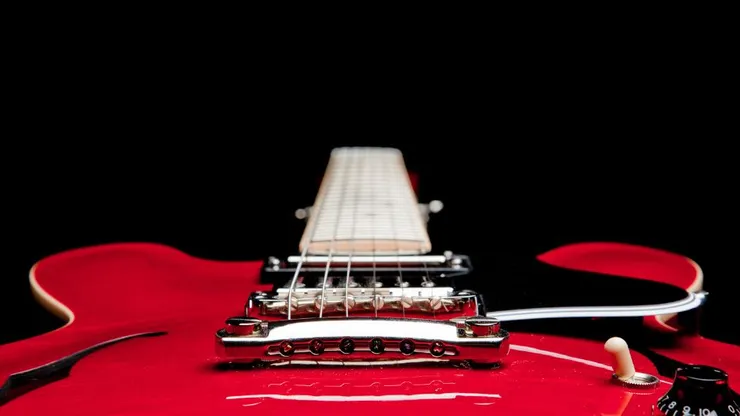Born in the Jazz Age, the hollow-body guitar is a piece of history. Musicians and collectors alike adore them for their enchanting tone, nostalgic aesthetics, and the sheer joy of playing them. But what is it that makes them so special? In this article, we’ll tell you everything you need to know.
What Is a Hollow-Body Guitar?
As the name suggests, a hollow-body guitar is a guitar that has a hollow sound chamber within its body. Picture a violin or cello. Well, the hollow-body guitar shares the exact same design feature of those instruments. While the hollow interior makes the guitar lighter, it also provides excellent feedback resistance. It’s this very characteristic that gives the hollow-body guitar its distinctly warm, robust, and resonant tone.
Hollow-body guitars are primarily associated with jazz, folk, and blues music, but their use certainly isn’t limited to these genres. You’ll find them in rock and roll, pop, and even country music. The hollow-body guitar is a fantastically versatile instrument, adding richness to any musical composition. With its ability to go unplugged for a pleasing natural sound or amped up for a raw, electrifying performance, it’s a versatile workhorse for various musicians.
How Do Hollow-Body Guitars Sound?
The sound produced by a hollow-body guitar can only be described as rich and full-bodied, resonating within the instrument’s hollow space before it reaches your ears. An undeniable sonic charm sets these guitars apart from their solid-bodied associates. When the pick hits the strings, it sets off a chain reaction that culminates in a beautifully warm and rounded tone. This is mainly due to the resonance created within the hollow body, which adds depth and dimension to the sound that solid-body guitars simply can’t match.
This isn’t to say that hollow-body guitars are superior; they just offer a different flavour of sound that’s unique and alluring to many. Moreover, the hollow body enables guitarists to play at lower volumes without losing any of the instrument’s natural tonal characteristics. For musicians playing in intimate settings, this can be a game-changer. Add the ability to produce incredible feedback when hooked up to an amplifier, and you have a versatile instrument perfect for both the studio and the stage.
The hollow-body guitar’s ability to transition seamlessly between genres is another testament to its flexibility. The hollow-body guitar can do it all, from the soulful licks of a blues solo to the energetic strumming of a rock performance.
Style and Versatility
With their pleasing, full-bodied sound, hollow-body guitars have carved out a unique niche in the music world. They are a favourite of many musicians for their versatile character and expressive tone, a testament to their thoughtful design and craftsmanship.
From the golden era of jazz to the birth of rock ‘n’ roll, hollow-body guitars have left their mark on various music genres. But what sets these guitars apart isn’t merely their resonant sound but their ability to adapt to an artist’s individual style. They can bring a sultry blues performance to life with their raw, emotional tone and equally excel in delivering the adrenaline-fuelled sound of a rock concert. This versatility extends to the stage and studio alike, proving their value in both live performance and recording situations.
Another unique aspect of hollow-body guitars is the feedback they produce. In the hands of a skilled musician, what might be seen as a downside becomes an advantage, creating a dynamic, interactive playing experience. The artist can manipulate this feedback, harnessing it to create additional sonic textures, further expanding the instrument’s capabilities.
Ultimately, the hollow-body guitar is a vehicle for expression, enabling artists to convey their deepest feelings and most profound thoughts through the universal language of sound.
Unique Features
Hollow-body guitars offer an array of features that cater to the specific needs of musicians. One of the most notable design elements is the f-hole, borrowed from the world of orchestral string instruments. The f-hole amplifies the guitar’s natural resonance, creating a warm, rich sound perfect for jazz and blues. High-quality tonewoods like maple, mahogany, and spruce further enhance this tonal richness. They add depth and complexity to the sound, making each note feel full and alive.
In addition, many hollow-body guitars carry dual pickups, allowing musicians to switch between distinct tonal profiles, from the bright, twangy sound ideal for country music to the warm, mellow tones favoured by jazz musicians. Furthermore, the inclusion of volume and tone controls directly on the guitar body allows for on-the-fly adjustments, providing the player with a greater level of control over their sound.
The hollow-body’s aesthetic appeal, with its elegant curves and glossy finishes, is another distinct feature that sets it apart. It’s almost as much a visual statement as a musical instrument, reflecting the artist’s personality and style. Even in the era of digital music production, these guitars continue to be the instrument of choice for many artists, offering a tactile, interactive musical experience that no digital tool can replicate.
Are Hollow-Body Guitars Expensive?
The cost of hollow-body guitars can vary considerably, reflecting factors such as brand reputation, materials used, the level of craftsmanship, and the particular model. For those on a budget, entry-level hollow-body guitars can be found for under �300, providing a fantastic opportunity to explore the unique tonal landscape these instruments offer without breaking the bank.
On the other hand, high-end models, crafted with the finest materials and exhibiting exceptional artistry, can run into the thousands. These premium guitars are often the choice of professional musicians, who appreciate their superior sound quality, playability, and aesthetic appeal. That said, it’s essential to remember that a higher price tag doesn’t always equate to a better fit for every player. The best hollow-body guitar for you will be the one that aligns with your budget, playing style, and musical preferences. Investing time in researching and trying out different models can be rewarding, leading you to the instrument that resonates with your style and ambition.
Are Hollow-Body Guitars Any Good?
Hollow-body guitars, without a doubt, have a rich heritage, and they’re just as relevant and exciting today as they were when first introduced. The versatility of these instruments is remarkable. Whether you’re a jazz aficionado, a roots-rock rebel, a punk pioneer, or you’re just starting out and finding your sound, there’s a hollow-body guitar that can help you achieve your musical goals.
Their distinctive, warm tone sets them apart from their solid-body counterparts, adding a new dimension to your sound. Furthermore, they’re often lauded for their comfortable playing experience; the reduced weight and ergonomic design make them a pleasure to play for extended periods.
While they do require a little more care and attention due to their delicate nature, many players find this a small price to pay for the unique benefits they offer. Ultimately, the value and suitability of a hollow-body guitar all come down to personal preference. The key is to keep an open mind, explore different options, and find the instrument that feels right for you.
Find Your Perfect Hollow-Body Guitar
The hollow-body guitar is an instrument that possesses a unique allure. Its distinctive shape, resonant chamber, and warm tones create a captivating musical experience that has stood the test of time. Whether you’re a seasoned musician looking to expand your sonic palette or an aspiring guitarist finding your feet, a hollow-body guitar can provide a fascinating musical journey.
So, if you’ve decided to take the plunge and pick up your own hollow-body guitar, isn’t it time to try out our Finder tool? Simply enter your guitar must-haves, such as body type, tonewood, and price range, and find your perfect guitar today!

